I am trying to make Visual programming system using tkinter. That is what I have for now:

I need to be able to move nodes by mouse. All nodes have a main frame, that I am moving using place method. I have created a funcion with place method and attached it to the "Motion" event. But then if I move nodes too fast, I can see the temporary "path" made of last positions of a node:
 I am not sure why this happens. My guess is that it may be hard to complete lots of place function at small time, so just can't update screen too fast. Or maybe that is somehow related to the bindtags.
Parts from code. From init:
I am not sure why this happens. My guess is that it may be hard to complete lots of place function at small time, so just can't update screen too fast. Or maybe that is somehow related to the bindtags.
Parts from code. From init:
[widget.bind("<Button-1>", self.start_motion) for (name, widget) in self.base_f.children.items()]
[widget.bind("<ButtonRelease-1>", self.stop_motion) for (name, widget) in self.base_f.children.items()]
Then start, stop motion and move node functions:
def start_motion(self, e: tk.Event):
[widget.bind("<Motion>", self.move_node) for (name, widget) in self.base_f.children.items()]
def stop_motion(self, e: tk.Event):
[widget.unbind("<Motion>") for (name, widget) in self.base_f.children.items()]
def move_node(self, e):
m_pos_x = root.winfo_pointerx() - root.winfo_rootx()
m_pos_y = root.winfo_pointery() - root.winfo_rooty()
self.base_f.place(x=m_pos_x, y=m_pos_y)
Some explanation: All widgets from "node" class are children from a main_base_frame(base_f). I want binding happens only on specific widgets touched by a mouse (that is where that lists come from, only touched children of base_f will make node to be able to move). Move node just move node to position of cursor. Here is a simple code example to try:
import tkinter as tk
class SimpleClass:
def __init__(self):
self.frame = tk.Frame(width=200, height=100, bg="black")
self.frame.place(x=0, y=0)
self.frame.bind("<Button-1>", self.pressed)
self.frame.bind("<ButtonRelease-1>", self.release)
def pressed(self, e):
self.frame.bind("<Motion>", self.move)
def release(self, e):
self.frame.unbind("<Motion>")
def move(self, event: tk.Event):
m_pos_x = root.winfo_pointerx() - root.winfo_rootx()
m_pos_y = root.winfo_pointery() - root.winfo_rooty()
self.frame.place(x=m_pos_x, y=m_pos_y)
root = tk.Tk()
root.geometry('1200x1000')
cl = SimpleClass()
root.mainloop()
I am really interested why this happens and how can I fix this. Maybe there is a function that will freeze place method until window has finished all updates or something like this. Thanks.
P.S. Don't hate me for using the tkinter library for purposes it was not intended for.